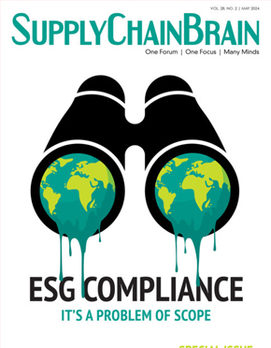
To cope with the seemingly never-ending supply chain crisis, business leaders are turning to artificial intelligence to make strategic business decisions. A recent survey by PwC found that 48% of business leaders use AI to drive supply chain decisions, and 54% of business leaders plan to use AI-driven simulations to enhance supply chain operations.
AI allows for simulations of vast amounts of data from suppliers, customers, competitors, and external factors like weather or geopolitical events. In the process, leaders can better predict supply chain dynamics and disruptions, and have the most up-to-date integrated business plans in place to navigate the complexities of a rapidly shifting business environment.
Leaders taking a holistic approach to AI can realize three overarching benefits:
- Supply chain transformation. Companies that approach AI comprehensively across their supply chains are roughly twice as likely to report substantial value from initiatives to improve productivity, decision-making, the employee experience, product and service innovation, the customer experience and more.
- Enhanced decision-making. By bringing together so many observations and insights from inside and outside the organization, a comprehensive AI approach facilitates scaled data processing and cross-functional correlations that foster repeatable, consistent strategic insights and enable business-relevant decisions that deliver valuable outcomes quickly.
- Systems modernization. Thirty-six percent of companies with a comprehensive approach to AI are planning to use it this year to help create a data fabric —a 360-degree view of all data that touches their organizations and drives end-to-end value from critical functions within the supply chain.
As leaders look to implement AI within their operation, they should focus on five priorities:
Think efficiently, long-term. Seventy-four percent of tech leaders are using AI for decision-making. AI streamlines the process by enabling organizations to analyze more data than any one person could on their own. For business leaders, it can estimate possible outcomes of price changes, customer satisfaction and product availability.
Start with desired outcomes instead of existing data. Then then search for the data and analytics to support it.
Let AI make your data actionable. Use it to filter the data to select only what you need. It’s common for companies to have disorganized data in their systems, so use AI to extract exactly what you need, then put this data to work.
Focus, then scale. It’s unrealistic to tackle everything at the same time. Start small with only one piece of the business, like estimating a single facility’s carbon footprint, then scale to other facilities and factors.
Simulate everything. By modeling huge numbers of supply chain scenarios in parallel, simulations let you quickly forecast likely events and “game out” your best real-world actions before taking real-world risks. Nearly two-fifths of “comprehensive” companies are using AI simulations to help optimize resources. AI-powered virtual reality simulations enable better virtual suppliers, improve access networks across geographies, enhance monitoring of remote inputs, and optimize logistics nodes.
These simulations may even help overcome talent challenges over time. Almost half of “holistic” companies are using AI simulations in their recruitment and onboarding processes to access talent without geographical constraints, monitor remote workers and to upskill existing employees.
Use AI to create data. A data insights platform, with repeatable data pipelines to ingest, prepare, stage and report on data, can automate much of this process, enabling data scientists to spend their time on insights around the supply chain nodes.
Make digital twins. These help make sense of data sets in the context of your business, customers and products. Consider this when using AI’s power to create business-relevant simulations.
Align your focus. Help your employees and data scientists align goals, roles and processes around your most impactful opportunities. By bringing simulation specialists and data (engineering) specialists together, you increase the probability of creating innovative solutions to simulation problems.
Put a number to it. By fostering scale, shared insights, and shared best practices, AI makes it easier to predict the return on investment from of new initiatives. Companies can answer these uncertainties using the new assessment methods. AI captures hard returns such as increased productivity, and soft returns like improved employee experience.
As you work to measure and maximize AI’s ROI, you may also be able to take advantage of AI itself: Its simulations can model the uncertainties that surround other AI initiatives, helping to better allocate resources.
Be complete. Use the new methods to assess and predict AI’s ROI while factoring in variables like uncertainties or changes in model performance.
Build a portfolio. Create and assess a mix of initiatives that will raise the probability of achieving the desired outcomes.
Manage the lifecycle. By aiming to manage an integrated data-AI-cloud (DAC) rather than individual projects, you can evolve strategy, fine-tune execution and find new use cases for data.
Protect yourself. Only 57 % of leaders say AI is compliant with applicable regulations, and even fewer (41%) review to be sure that third-party AI services meet standards. Although most companies have responsible AI ambitions, these numbers are not enough.
Responsible AI requires both technology and business experience. AI professionals may not be aligned with compliance, and business experts may lack the technical skills to forecast complex algorithms. Together, they can obtain positive AI results while remaining confident in their regulation compliance.
Govern the lifecycle. Because AI models are ever-changing, deploy end-to-end governance of the DAC lifecycle. This should include risk, AI and business leaders, with new procedures, roles and responsibilities for each.
Assess the impact. Consider algorithmic impact assessments to capture risk, identify governance needs, increase accountability and facilitate decisions.
Minimize bias. Make sure AI is treating all your stakeholders fairly.
Recruit, retain and automate. AI initiatives are providing budget headroom, either through either cost savings or enhanced revenue, for a different workforce talent profile, allowing companies to retool for the future. Fifty-eight percent of companies are seeing higher-than-normal supply chain employee turnover, yet only 23% say they have the necessary digital skills to meet goals. Companies using AI holistically continue to grow despite labor market challenges, because they’re more likely to retrain in-house talent and reorganize teams to fill in AI experience gaps.
Do more with less AI. AI can help people more efficiently complete routine tasks and AI-specific roles. This reduces the pressure to fill specialized positions and saves employees’ time.
Make employees happier. AI can help provide emotional support in the workplace, fighting burnout by increasing the value derived from training.
Invest in data-driven people. Teach the specialists you already have additional skills, such as data science for computer scientists and software engineering for data scientists. In addition to filling talent gaps, this is another way to build governance and group efforts.
AI offers supply chain professionals the ability to assess and optimize their supply chains in real time, overcoming what used to take weeks and months to achieve. The delayed timelines of the past were so tardy that it was difficult to create and display value. Today, during scarcity, inflation and geopolitical shifts, the planning and optimization stages must be streamlined from yearly events to daily (or even hourly) occurrences — something that only AI can provide.
Today, nearly 50% of business leaders are already using AI to make supply chain decisions and planning to use AI simulations to enhance operations. And the number of those leaning into the technology will only increase in the coming months and years. By advancing with AI in three areas at once — supply chain transformation, enhanced decision-making and modernized systems — companies are rising above those that are focusing on one goal at a time.
Matt Comte is operations transformation practice leader at PwC.



.jpg?height=100&t=1715228265&width=150)
.jpg?height=100&t=1715141311&width=150)


